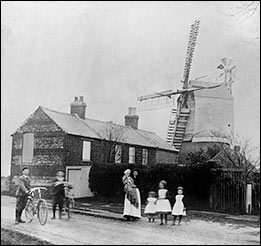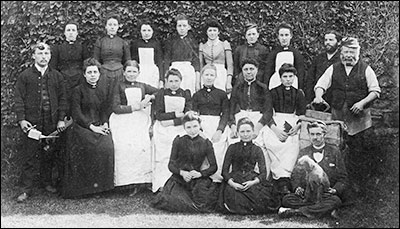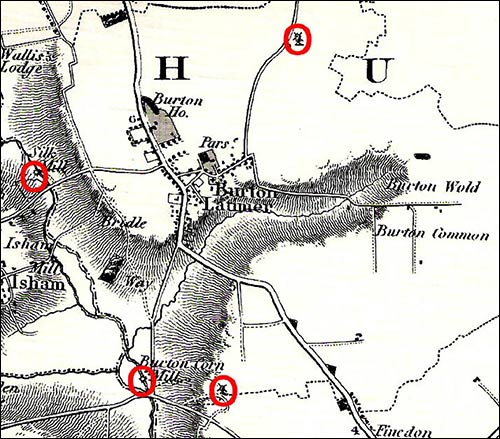|
Like many other places, there is little written evidence to tell us what life was like in Burton Latimer after the Domesday Book had provided us with a ‘snapshot’ in 1086.
17th century Manor Court
records and 18th century militia lists show mainly agriculture related occupations before the enclosure of the common fields in 1804, and most of the male inhabitants of the village would have worked on the land as labourers, tenant farmers or smallholders. Some worked at home as weavers and some would have found employment at the north mill on the River Ise, which had gone through several changes of use since medieval times, but which provided alternative employment to being agricultural labourers.
However, Burton Latimer, like most other similar villages, remained a predominately farming community until the mid 1800s and then commerce and industry began to replace the declining agricultural and home weaving industries. The importance of agriculture is shown by number of former farmhouses in the town, and others have disappeared over the years.
|
|
The location of the mills in Burton Latimer.
To read more of the history of Burton mills, click here
|
|
The north mill site in Station Road is now occupied our largest employer Weetabix Ltd., and is an example of the changing ‘job opportunities’ in the town. The Priory of Bradenstoke (Wilts) had property in Burton Latimer by 1222, including a mill called “Byggemull” (big mill?). A pre 1234 document at the National Archives records a grant of 40 shillings rent owed by Aubrey de Burtoun from the mill of Burton Latimer (Burtoun)., but to which of the two mills these refer is unclear
After having been a corn mill since medieval times, references have been found to the north mill having been used as a fulling mill (1733), cotton mill (1794), silk mill (1826); the manufacture of worsted cloth (1838) and carpets (1851); a woollen mill (1853) chicory and mustard grinding and flour (1861-76) and then back to flour and animal feeds production again before the manufacture of breakfast cereal began in 1932.
The south mill, in Finedon Road, now a private home, was also mentioned in the Domesday Book, and it continued to be used as a corn mill over the years. It was occupied by Thomas Pichley in 1630/40 but no further mention of it by name can be found until the early 19th century when it was a corn mill and owned by Thomas Garratt. In the 1870s it was owned by Burr Bros., corn millers, and converted from water power to steam in the 1890s; it has since had other uses including sausage skin manufacture c1914 and tanning. It was during this latter use that it was largely destroyed by fire in 1936 when it was in the ownership of CE & HB Groome Ltd.
 |
|
The windmill in Cranford Road c.1906
|
|
There were once two windmills. One was situated on the
Cranford Road
and owned by George Robinson in the early 19th century and later by, among others, Moses Irons Eady. It was bought by the Burton Ironstone Co. and demolished around the time of the First World War.
The other windmill stood in the fields north-east of the back road to Finedon and, for at least fifty years from the 1760s, it belonged to Thomas Garrett who also owned the nearby water mill. It was probably demolished in the second half of the 19th century.
After the arrival of the railway in 1857, the gradual transformation of the farming village to a small manufacturing town began. Lace making had offered the women and girls an alternative to work on the land or domestic service, but then work in the new boot, shoe and clothing factories provided more opportunities for both men and women (see image at foot of page). The first clothing factory, staffed mainly by women, was opened by Frederick Wallis and John Linnell (a Burton Latimer farmer’s son) in 1885 and the first boot factory was built by Henry Whitney and Joseph Westley in 1898. Ironstone mining employed many men from the 1870s right up to the early 1920s when the ironstone ran out in Burton Latimer but many miners and quarrymen continued to travel to work at
Cranford
, Finedon and Irthlingborough. Brick and tile making started the 1850s and employed many men and boys until the early 1900s. The success of the town’s entrepreneurs, many of whom had started their businesses in home workshops and then later built shoe factories, meant that working in the footwear industry was soon the occupation of the majority of male workers. In 1923, there were four large factories making boots and shoes, a leather tannery and seven clothing manufacturers employing hundreds of women and girls. Several of the factory owners and businessmen were responsible for providing amenities which benefited the whole community. The Electric Palace Cinema was built by shoemakers Joseph Westley and Henry Whitney together with A.G. Miller who had a successful plumbing and decorating business. Shoemaker Joseph Eady built the Pavilion which stood behind the row of shops in the High Street now occupied by Arthur Turner Ltd and others. Twenty years later a quarry owner, Thomas Gray, built the Isebrook Swimming Pool in
Polwell Lane
.
 |
| Workers at Wallis & Linnell's clothing factory c.1900 |
|
|


